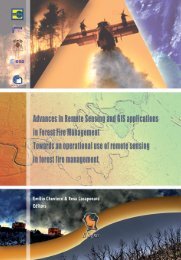EARSeL Newsletter - EARSeL, European Association of Remote ...
EARSeL Newsletter - EARSeL, European Association of Remote ...
EARSeL Newsletter - EARSeL, European Association of Remote ...
You also want an ePaper? Increase the reach of your titles
YUMPU automatically turns print PDFs into web optimized ePapers that Google loves.
<strong>EARSeL</strong> <strong>Newsletter</strong> September 2002 - Number 51<br />
8<br />
River in a helicopter to get these images,"<br />
commented Dr Stefan Voigt, Charter coordinator<br />
for the German and Austrian requests,<br />
and the team leader for crisis and<br />
disaster management at the RS centre <strong>of</strong><br />
the German space agency (DLR).<br />
Overall, thirty images from the ERS and<br />
Envisat satellites had been provided so far<br />
to meet the Swiss, Austrian and German requests,<br />
and more were being prepared. The<br />
Synthetic Aperture Radars (SARs) <strong>of</strong> ERS<br />
are capable <strong>of</strong> penetrating cloud-cover and<br />
operating at night – significant advantages<br />
over instruments that operate in the visible<br />
frequencies. Each image is approximately<br />
100 mega-bytes in size, and was provided<br />
to the users over the Internet, via an FTP<br />
connection.<br />
Data could help build flood models<br />
The coordinator <strong>of</strong> the Swiss effort to support<br />
the delivery <strong>of</strong> pumps and power generators<br />
to flooded areas in the Czech<br />
Republic, Dr Urs Frei <strong>of</strong> the RS laboratoriess<br />
at the University <strong>of</strong> Zurich, said that<br />
the ERS data are being used to generate a<br />
digital elevation model (DEM) to assist authorities<br />
in planning for future flood scenarios.<br />
"The DEM could help to simulate<br />
different scenarios – which areas would be<br />
flooded depending on the water level," he<br />
said.<br />
The Envisat imagery that was sent was<br />
captured using ASAR’s alternating polarisation<br />
mode that improves the capability <strong>of</strong><br />
a SAR sensor to classify different types <strong>of</strong><br />
terrain, discriminating between, for instance,<br />
flooded lowlands and adjacent<br />
land. The sensor is the latest generation <strong>of</strong><br />
radar instruments with increased capabilities<br />
over the ERS SAR sensors, while maintaining<br />
a continuity <strong>of</strong> service to users.<br />
Imagery to national, regional and local<br />
users<br />
The ERS imagery was the first data <strong>of</strong> the<br />
flooding provided under the Charter requests,<br />
said Voigt, adding that ESA images<br />
were being sent even prior to the formal activation<br />
<strong>of</strong> the Charter, by ESA’s Earth<br />
Watching project that tries to anticipate<br />
trouble spots and make available both<br />
archived data and current imagery. In addition<br />
to the ESA data, imagery was pro-<br />
vided by CNES, the French Space Agency<br />
and its SPOT Earth observation (EO) satellites,<br />
the Canadian Space Agency’s<br />
Radarsat, and the Indian IRS sensor.<br />
The imagery proved valuable during the<br />
recent flooding, by providing various crisis<br />
management teams with an overview <strong>of</strong><br />
the situation on a large scale. Users ranged<br />
from government agencies on the national<br />
and regional levels, down to local authorities,<br />
relief agencies and civil protection<br />
groups. Specifically, the data were used to<br />
fine-tune hydrological models that look at<br />
flooding in upstream areas and attempt to<br />
predict where the worst downstream<br />
flooding will occur in a few days time, said<br />
Voigt, adding: "We have a saying: after the<br />
flood is before the next one."<br />
The "after-the-flood" applications could<br />
prove even more beneficial for coping with<br />
this event, and providing data that could<br />
help mitigate the next one. Voigt said that<br />
the satellite data are expected to be used to<br />
assess damage claims for insurance purposes,<br />
provide government authorities with<br />
needed data for reimbursement to local<br />
agencies <strong>of</strong> reconstruction costs, and allow<br />
more precise analyses <strong>of</strong> the flood’s impact<br />
on agriculture, reservoirs, wildlife reserves<br />
This Envisat radar image <strong>of</strong> the Elbe valley in<br />
Sachsen (Germany) was taken on 19th August 2002,<br />
around 11:30 (local time). It shows the flooded areas<br />
at that time (in black or blue). The flooded areas are<br />
particularly large around the city <strong>of</strong> Riesa. This<br />
image demonstrates the increased capabilities <strong>of</strong> the<br />
Advanced Synthetic Aperture Radar (ASAR) on<br />
Envisat, as compared with the SAR sensors <strong>of</strong> ERS,<br />
while <strong>of</strong>fering a continuity <strong>of</strong> service to users
















